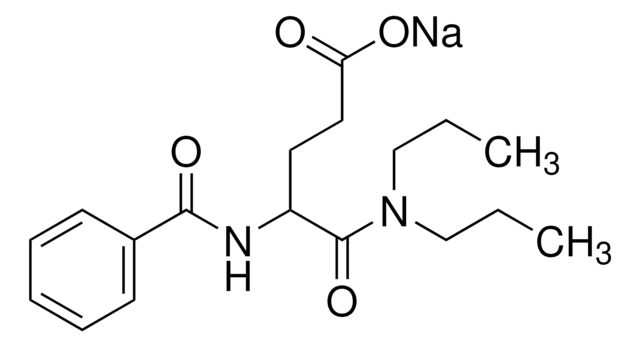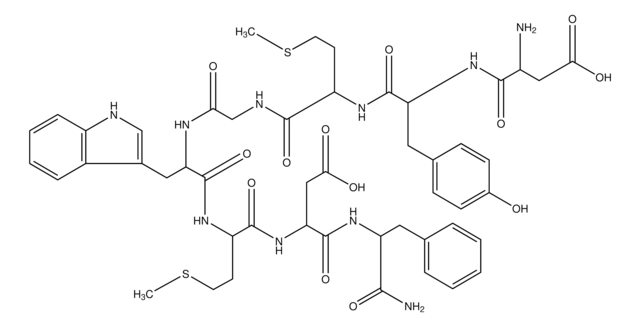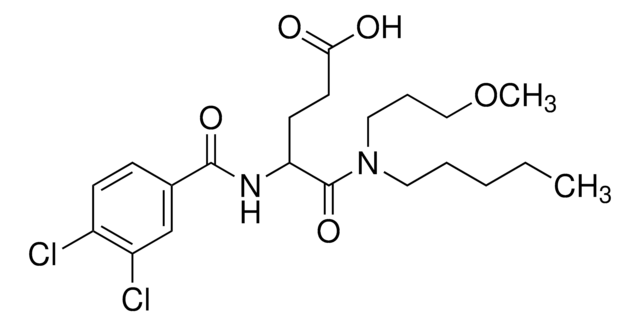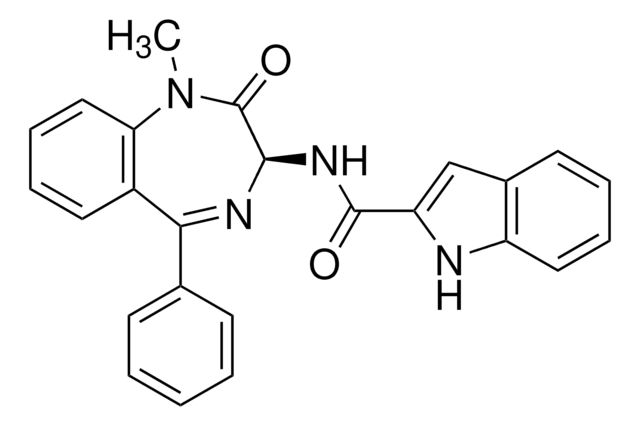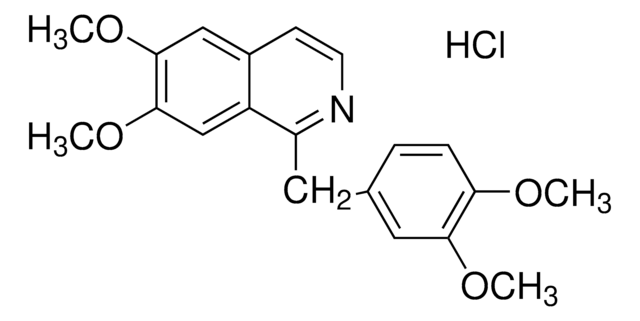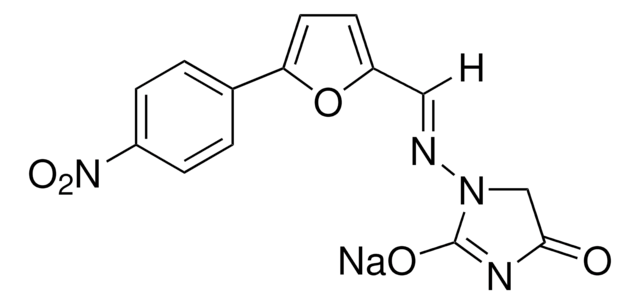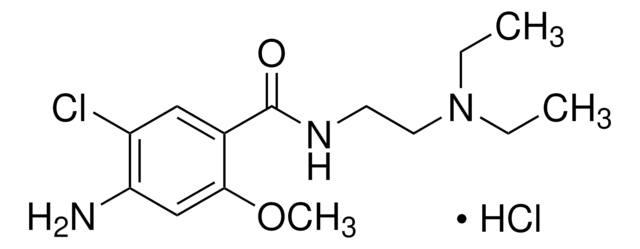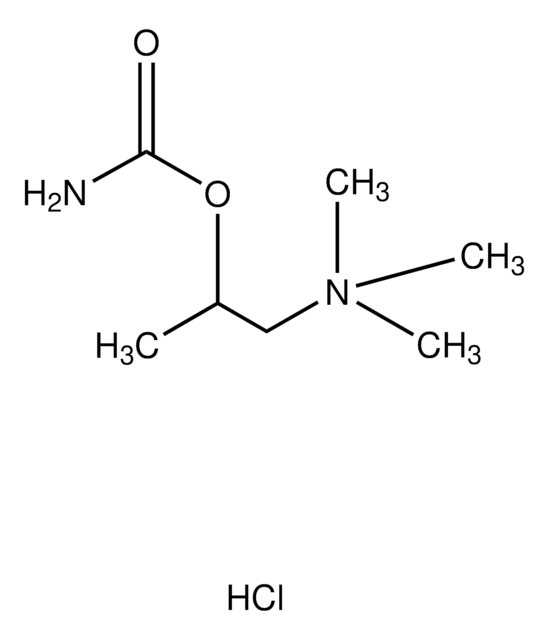추천 제품
양식
solid
색상
white
solubility
45% (w/v) aq 2-hydroxypropyl-β-cyclodextrin: >10 mg/mL
H2O: 10 mg/mL
methanol: 28 mg/mL
SMILES string
[Na+].CCCCCN(CCCCC)C(=O)C(CCC([O-])=O)NC(=O)c1ccc(Cl)c(Cl)c1
InChI
1S/C22H32Cl2N2O4.Na/c1-3-5-7-13-26(14-8-6-4-2)22(30)19(11-12-20(27)28)25-21(29)16-9-10-17(23)18(24)15-16;/h9-10,15,19H,3-8,11-14H2,1-2H3,(H,25,29)(H,27,28);/q;+1/p-1
InChI key
JCNPYMDDOUQTBK-UHFFFAOYSA-M
유전자 정보
human ... CCKAR(886)
애플리케이션
Lorglumide sodium salt has been used as a cck-a (cholecystokinin A) receptor antagonist for peptide determination in rat islet cells. It has been used as a CCK1 inhibitor to check the effect of cck1 (cck-a) and cck2 (cck-b) receptors on cerulein-induced upregulation of egr-1 (early growth response 1) expression in rat pancreatic acinar cells.
생화학적/생리학적 작용
Potent and selective non-peptide cholecystokinin (CCKA) receptor antagonist; orally active.
Storage Class Code
11 - Combustible Solids
WGK
WGK 2
Flash Point (°F)
Not applicable
Flash Point (°C)
Not applicable
개인 보호 장비
Eyeshields, Gloves, type N95 (US)
F Makovec et al.
Arzneimittel-Forschung, 37(11), 1265-1268 (1987-11-01)
Derivatives of 5-(dipentylamino)-5-oxo-pentanoic acid are a new class of non-peptide cholecystokinin (CCK) antagonists. The most potent compound, D,L-4-(3,4-dichlorobenzoylamino)-5-(dipentylamino)-5-oxo-pen tanoic acid (lorglumide, CR 1409), has a great affinity for the pancreatic CCK receptors and is a competitive, specific and potent CCK
M D'Amato et al.
British journal of pharmacology, 102(2), 391-395 (1991-02-01)
1. Three recently described non-peptide cholecystokinin (CCK) antagonists (devazepide, lorglumide, loxiglumide) have been studied for their antagonism of the contraction to cholecystokinin-octapeptide (CCK-OP) in human alimentary muscle and guinea-pig intestine. 2. Each antagonist caused a concentration-dependent inhibition of the contraction
Yukio Ikeda et al.
Biochemical and biophysical research communications, 333(3), 778-786 (2005-06-22)
The glucose-induced insulin secretion is fine-tuned by numerous factors. To systematically identify insulinotropic factors, we optimized a primary beta-cell-based functional assay to monitor intracellular Ca2+ flux ([Ca2+]i). By this assay system, we successfully identified several insulinotropic peptides including cholecystokinin, gastrin
H W Suh et al.
Peptides, 16(7), 1229-1234 (1995-01-01)
Various doses of sulfated cholecystokinin octapeptide (CCK-8s) injected intracerebroventricularly (ICV) alone did not show any antinociceptive effect. CCK-8s (0.01-1 ng) pretreated ICV for 10 min dose-dependently attenuated the inhibition of the tail flick response induced by ICV-administered morphine (2 micrograms).
G L Edwards et al.
Annals of the New York Academy of Sciences, 897, 192-197 (2000-02-17)
Ingestion of food and fluid stimulates release of a number of peptides from the gastrointestinal system. These peptides are recognized to act as neurotransmitters/neuromodulators and act at both peripheral and central receptors. Many studies indicate that these peptides are important
자사의 과학자팀은 생명 과학, 재료 과학, 화학 합성, 크로마토그래피, 분석 및 기타 많은 영역을 포함한 모든 과학 분야에 경험이 있습니다..
고객지원팀으로 연락바랍니다.![(Tyr[SO3H]27)Cholecystokinin fragment 26-33 Amide ≥97% (HPLC), powder](/deepweb/assets/sigmaaldrich/product/structures/125/021/32eb71ec-73e5-4cfc-94d0-ebcf5e784e39/640/32eb71ec-73e5-4cfc-94d0-ebcf5e784e39.png)
